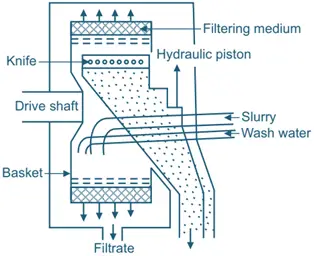Principles of Semi-Continuous Centrifuge
- The semi-continuous centrifuge operates on the principle of centrifugal force to separate components of a slurry based on density differences.
- Unlike batch centrifuges, semi-continuous centrifuges allow for periodic discharge of solids without stopping the entire process, providing a balance between continuous and batch processing.
Construction of Semi-Continuous Centrifuge

- Rotor/Basket: Typically, a solid-walled or perforated drum that rotates at high speeds.
- Feed System: Mechanism to continuously feed the slurry into the centrifuge.
- Discharge Mechanism: Automated system to periodically discharge accumulated solids without stopping the centrifuge.
- Drive System: Motor and spindle to spin the rotor.
- Control Panel: For adjusting operational parameters like speed, feed rate, and discharge intervals.
- Housing: Outer casing to contain the process and collect separated liquids.
Working
- Feeding: The slurry is continuously fed into the rotating drum.
- Separation: The centrifugal force separates the components, with denser solids moving to the outer wall and liquids moving toward the center.
- Intermittent Discharge: At preset intervals, the solids are discharged through an automated system (such as a scraper or discharge valve) without stopping the centrifuge.
- Continuous Collection: The separated liquid flows out continuously through an outlet.
Uses
- Chemical and pharmaceutical industries for the separation of crystalline or precipitated solids from liquids.
- Food and beverage industry for juice clarification and sugar crystallization.
- Wastewater treatment for sludge dewatering.
- Oil industry for separating oil and water from solids.
Merits
- Combines the benefits of batch and continuous centrifuges.
- Reduces downtime as solids are discharged intermittently without stopping the process.
- High efficiency in solid-liquid separation.
- Can handle large volumes with consistent throughput.
Demerits
- More complex construction and operation compared to batch centrifuges.
- Higher initial cost due to additional automation.
- Requires precise control and maintenance to ensure proper intermittent discharge.
- Limited to applications where periodic discharge is acceptable.

